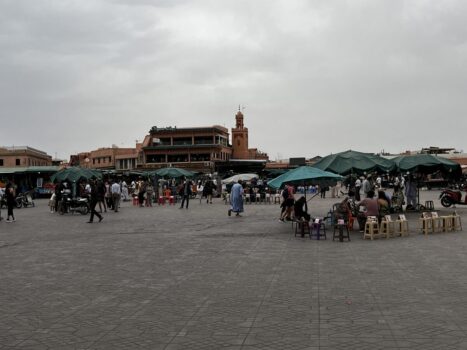My Peru trip last year left me with a deep appreciation for ancient civilizations – the way Incan culture has shaped everything from architecture to daily life was simply fascinating. That experience encouraged me to continue connecting with more cultures around the world, especially those I’d rarely had the chance to explore. Life is all about exploring! 😊
After browsing through possible destinations, Morocco caught my eye. The magnificent palaces that have witnessed centuries of history, the religious Islamic culture, and the profound Arab-Berber traditions… I eventually put Marrakech on the pin as my next solo adventure and my first step into Africa. 🗺️
As with any solo trip, I did my homework (you know me! 😉). Here’s everything I learned while exploring the mysterious Red City…
🗺️ Full Itinerary Map
🎒 Day 1-2: Exploring the Medina
My Marrakech adventure began with a night arrival. The owner of Riad Dar Aid arranged a pickup from the airport, and greeted me with a pot of hot and sweet mint tea – my first taste of Moroccan tradition. 🫖 As I sat in the peaceful riad courtyard that evening, the reality slowly sank in – just yesterday I was in Toronto, and now I’m here in North Africa, about to embark on another solo adventure. Super excited! 🤗
Travel Tips:
- Always arrange airport transfers in advance when arriving at night 😉
- If you’re planning to use your phone in Morocco (which you definitely should for maps and ride-hailing), getting a local SIM card is super important. Check out my blog ‘🇲🇦 Marrakech Travel Guide – Things to Know Before Planning‘ for available SIM card options!
Morning
My riad’s location turned out to be perfect – just a 5-minute walk from the Saadian Tombs, which was my first stop the next morning. Built in the 16th century during Sultan Ahmad al-Mansur’s reign, these tombs were a testament to Moroccan craftsmanship. The colorful zellige tiles, elegant Carrara marble, cedar wood ceilings, and the delicate carved stucco walls were purely unbelievable. I kept wondering how people from the 16th century could create such precise and beautiful work without modern tools. Each room told a story about the Saadian dynasty.




Afternoon
After lunch at Zeitoun Café (their vegetable tagine was delicious!), I made my way to the Bahia Palace. “Bahia” means “brilliance” in Arabic. The place was built much later in the late 19th century (1860s), representing a different period in Moroccan history and architecture. It has stunning interiors across over 150 rooms, known for its courtyards with fountains and gardens, making me feel like I stepped into an oasis in the middle of the desert. Its bright yellow and blue ceramic screens, featuring exquisite Andalusian-style vegetal sculpture, added an additional elegance to the palace’s interior.


The ruins of the El Badi Palace offered a different view. “Badi” means “incomparable” in Arabic. It used to have 360 rooms, a large courtyard, and a central pool, all adorned with zellige tiles, carved stucco, marble, and even an exotic zoo. While built around the same time as the Saadian Tombs during the Saadian dynasty, Badi Palace was later raided and destroyed by Sultan Moulay Ismail, who used the material to build his palace. The Saadian Tombs, however, were managed to be hidden and preserved until rediscovered later in 1917.


I continued my way to Jemaa el-Fnaa, the lively square that has been the heart of Marrakech since its founding in the 11th century. Throughout its rich history, it has served as a marketplace, a site for public executions, and a venue for cultural and religious events. Wandering through the square, I felt a deep connection to this living history that has witnessed the stories of countless generations over the centuries.
Travel Tip: Be careful of tourist traps in Jemaa el-Fnaa! Avoid taking photos with performers, as they’ll demand payment or become aggressive if you don’t pay them what they expect. If you really want to take photos with them, it’s best to agree on a price before engaging with them and to politely decline if you’re not interested.


Before returning to my riad for the night, I took a detour to visit the Koutoubia Mosque – Marrakech’s largest mosque and most iconic landmark – and the historic Bab Agnaou, one of the city’s 19 ancient gates.
As I sipped on a yummy avocado smoothie at a rooftop restaurant overlooking the mosque, the afternoon call to prayer began echoing from the tower. In that moment, the city seemed to pause. A wave of peace and calm washed over me, and for a second, it felt like there was nothing else in the world but that voice travelling through the city.





📚 Related Posts
- 🇲🇦 Marrakesh Travel Guide – Things to Know Before Planning
- 🇲🇦 Marrakesh Travel Guide – Recommended Local Eats and Buys
- 🇲🇦 5-Day Solo Travel in Marrakesh, Morocco (Part 2)
- 🇲🇦 5-Day Solo Travel in Marrakesh, Morocco (Part 1)

📍 Plan Your Marrakech Adventure!
I’ve created a detailed Notion travel planner template that includes everything you need to explore this magical city! Inside you’ll find:
✈️ Complete travel tips & cultural insights
📝 Customizable packing lists
🏰 City must-see spots
🍽️ Local food & restaurant recommendations
💰 Expense tracker (with dirham conversion)
🗺️ Interactive Google Maps with all locations
Get Your Planner Here: 🏜️ Marrakech, Morocco 4-Day Travel Itinerary Planner




